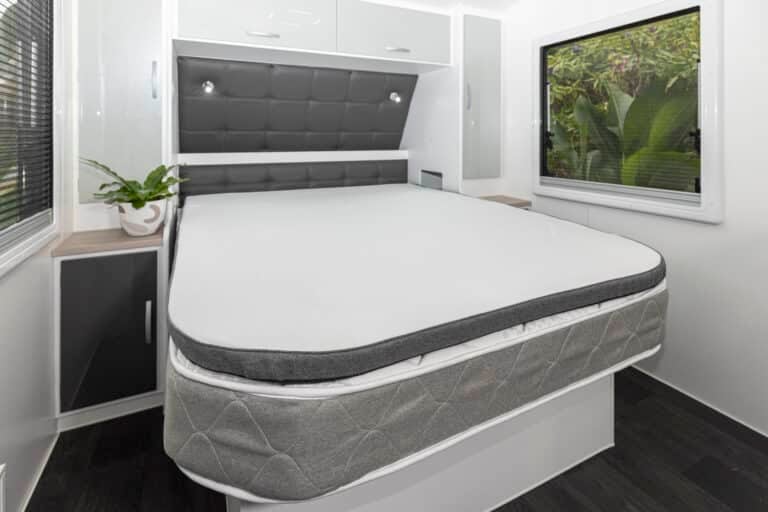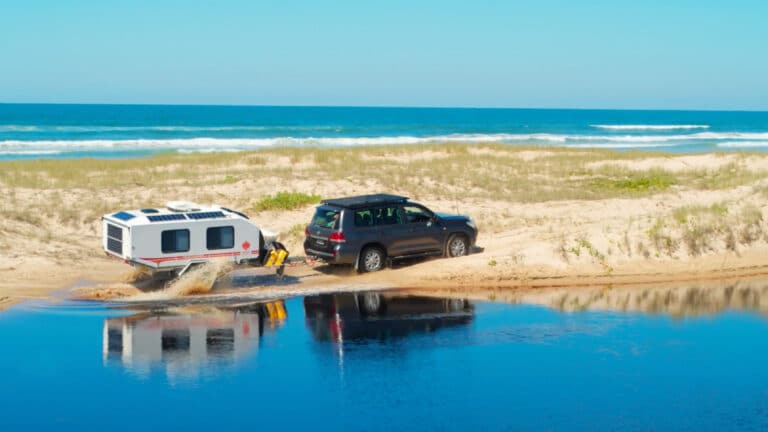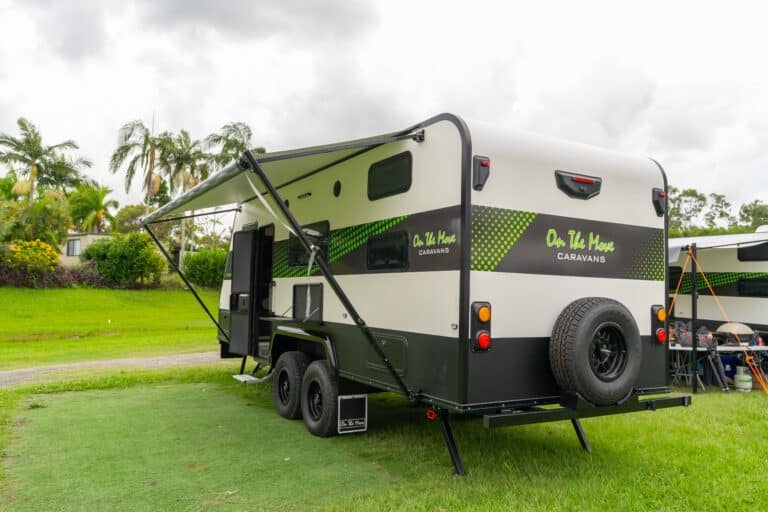
RVDaily borrowed a luxurious off-road hybrid camper, OPUS Campers‘ OP13, for a long weekend to check out its features. Read (and watch) our full review here.
OPUS Campers’ OP13 hybrid combines the full features of a caravan with the agility of an off-road camper trailer, bringing a fresh take on luxury camping. It comes in two layout designs, one for couples and one for those with kids featuring extra bunks. I got my hands on the couple’s layout for three nights, and although I didn’t get to do any serious off-roading with it, I did take it down a few gravel roads before setting it up in my backyard to explore its features.
Watch our video review below (or, if you prefer, keep reading).
Set up and first impressions
My first impression of OPUS Campers’ OP13 was that it was made to a quality standard. Having owned and/or reviewed lesser quality brands before, there were a number of things that stood out, such as heavy-duty hinges on the cabinetry, solid slide components, gas struts that actually work like they should, and just a solid build overall, indicating that the OP13 is not going to fall apart at the first sign of corrugations.
I was able to set it up on my own quite easily and in under five minutes. So, although this isn’t a walk-straight-in and go-to-sleep type camper, it’s really not too much of a bother once you learn the steps.
Also, the pop-top is electric. I never thought I would care about this feature, but I don’t think I can go back now. There is no winding of anything, simply press a button.

Off-road capability
As mentioned earlier, I didn’t get a chance to take it anywhere serious offroad, just on a few gravel/dirt tracks. But what it does have gives me confidence that I could, featuring heavy-duty Ironman suspension, 320mm ground clearance, mud-terrain tyres, galvanised steel chassis and a DO35 hitch. The OP13’s impressive rear departure angle means you’ll be able to take on tracks that other caravans wouldn’t attempt.
Off-grid capability
OPUS Campers’ OP13 is built for serious off-grid adventures, featuring 3 x 100Ah lithium batteries, a 2000W inverter (despite the fact that I accidentally said 200W in the video above), Renogy One Core Battery Management System (BMS), and 500 watts of solar power to keep you powered up even in the most remote locations. With 240 litres of fresh water, 67 litres of grey water capacity, and a complete ensuite, the OP13 ensures you can stay off-grid comfortably for extended periods without compromise.

Interior
The inside of OPUS Campers’ OP13 is where you start feeling the luxury. It includes a king-size bed, plush leatherette seating around a moveable table, plenty of storage, tinted windows providing an excellent view, conveniently placed charging points and a kitchenette.
For convenience, the camper includes a full ensuite with a Thetford toilet, shower, and sink. You’ll also find instantaneous hot water and air-conditioning with optional heating. It still gives off ‘hybrid vibes’ on the inside due to the pop-top, but a nice coloured doona cover will quickly breathe some life back into the interior if you can’t get past it.
Kitchen
As mentioned earlier, there is a sink and a bit of bench space inside OPUS Campers’ OP13 for when the weather is bad. However, as with all hybrids, the main kitchen is outside on various slides.
At the drawbar end of the OP13, you’ll find your fridge and slide and up the other end, you’ll find a slide-out kitchen featuring a sink, a four-burner gas stove and an extra extendable prep bench. In between the caravan door and the slide-out kitchen, you’ll find a pantry on a slide and a lockable storage area for your plates, cups and other kitchen items.


Towing
The towbar is a little on the short side, so for those towing with a ute, you may need an extender or to simply be mindful when reversing sharply. It towed fairly average behind my Triton MN. But let’s be honest: the MN is not built for towing and given that OPUS Campers’ OP13 has an ATM of 2,700, it was nearly at capacity. Because I wanted to make sure, I also towed it with a Toyota Hilux SR and a Mazda BT50.
The Toyota was at the very limit of its towing capacity, so I could really feel it, and I didn’t feel comfortable at all. However, the Mazda BT50 towed it nicely, and it was hard to tell that OPUS Campers’ OP13 was even there. A good reminder that when pairing a tow vehicle and caravan that you shouldn’t be towing at or even near the vehicle’s limit, instead aiming to be significantly under.
Other features
Other features of note include a generous amount of external storage given its compact size and a water tap on the drawbar.


What we love about OPUS Campers’ OP13
- Practical luxury (i.e. luxurious without being over the top)
- Compact size for ease of towing
- Electric pop-top
- It’s not ridiculously priced at just under $60K
What could be better about the OP13
- The sink is a bit shallow (a common problem with slide-out kitchens)
- The drawbar is a bit on the short side for those towing with a ute
- It’s a bit on the heavy side for a hybrid
Specs:
- Body work: one-piece walls, floor and roof
- Box material: aluminium frame, aluminium composite body with checker plate
- Dimensions (roof closed) mm: 6250(L) x 2200(W) x 2685(H)
- Chassis: 6″ hot dip galvanised chassis
- Trailer tare weight: 2350kg
- Ball weight (tare): 230kg
- ATM: 2700kg
- GTM: 2470kg
The verdict
Priced at $59,999 plus on-road costs, OPUS Campers’ OP13 is not ridiculously priced for the luxury it affords, representing genuine value for money compared to others. The real appeal of the OPUS OP13 is being able to see the wilder side of Australia yet still remain comfortable. And while I can’t (unfortunately) claim to have spent six months on the road with this hybrid van for a thorough review, I did notice in the three days that I had it that it appears to be solidly built to a quality standard. If I were in the market for a new hybrid, the OP13 would definitely be up there at the top of the list.
To check out the OPUS OP13 (and their other models), visit the OPUS Campers website.
Read next:











